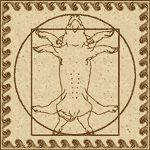
Caricature, Burlesque or Parody
The Vitruvian Swine is, of course, a fanciful combination of two familiar and iconic figures in Western culture – the pig and Leonardo da Vinci’s illustration of Vitruvian Man.
Vitruvian Man is a well recognized symbol today with diverse associations, yet it embodies concepts far older than da Vinci’s drawing. And the pig… Well, probably no other creature has offered up more of itself to the building of so many human cultures around the world. I created this image respectfully, as a means of representing how I see the influence of the pig on the human world.
Man, Circle, Square
Vitruvian Man is the synthesis of philosophical thought about the nature of man that began at least two millennium before da Vinci’s familiar drawing. The Greek philosopher, Pythagoras (580/572 – 500/490 BC), and followers of the Orphic religion believed in man’s potential divinity and envisioned a dual nature to man’s soul – mortal, yet in the image of the divine. They expressed that duality of man’s soul with the perfect geometric forms of the circle and square, symbols representing respectively, the heavens and mortal existence.
The Temple is Man
Moving forward some five hundred years, the Roman architect, Marcus Vitruvius Pollio (80/70 – after 15 BC), in his books on architecture, theorized that the necessary proportions for the construction of buildings should be based on the natural laws of harmony and beauty, best exemplified by the divine perfection of the human body’s symmetry and proportions.
Vitruvius explained his reasoning, stating that the human body is the earthly model of divine perfection as exemplified by how a human figure, with arms and legs extended, fits into both the perfect geometric forms, the circle and the square.
On this point, his original written work – De Architectura – was more descriptive than illustrative. This left future scholars, as well as editors of future editions of his work, puzzling over a means to draw a representative image of Vitruvius’ proportions of man. Attempts at illustration resulted in unsatisfactory human forms with disproportionate arms and legs because the figure was forced to fit inside both a circle and a square inscribed within it.
Finding the Shapes Around the Man
And then the Renaissance genius Leonardo da Vinci (1452-1519) read Vitruvius’ books on architecture – one of the few collections on that subject that survived into his time. Da Vinci saw the solution and created the image we know today and he called it Vitruvian Man.
The genius of da Vinci here was finding the ‘divine beauty’ where previous attempts at illustration had been unsuccessful. He did this by his choice to start by drawing a perfectly proportioned man and then finding and drawing the circle and square around that man. In da Vinci’s drawing the square was not inscribed in the circle, but tangent to it at their shared base. Divinity and the duality of the human soul are exemplified in this image that has endured to the present time.
A Contemporary Tableau
Today, da Vinci’s Vitruvian Man has diversified his portfolio and broadened his earlier representation of the soul’s duality. A near ubiquitous symbol and now more familiar outside religion, Vitruvian Man has been adopted by all the humanities, science, medicine, business and advertising.
While some still appreciate his history and the genius of the synthesis that created him, Vitruvian Man has also been transformed to suggest a modern embodiment of the Renaissance – an allusion to having contemporary conceptions with an eye to the best of what has past.
Whether factual or unfounded, he appears wherever folks want to suggest substance beyond the obvious. Vitruvian Man in the 21st century has become a marketing metaphor for worldliness and artistry, a tableau suggesting a higher awareness of whatever concept is being espoused.
The Path of Choice
Perhaps a marketing metaphor is the next millennial step in Vitruvian Man’s progression. I think any path is justifiable as a path if it leads somewhere. Yet to me, the figure of Vitruvian Man is still synonymous with duality, with interrelatedness: intellect and artistry, faith and science, circumstance and destiny.
And, as I tend to follow pig paths and think about the wide range of influences that acquaintance with and exploitation of the pig has brought about in human culture, I see another duality. Into that fertile mix of modern Vitruvian metaphors I suggest a consideration of all that the pig has added to human culture since pig and man first met nearly 100,000 years ago. Along that path the Vitruvian Man, in a simple, almost Circean, transformation becomes a pig – the Vitruvian Swine.
Wallow Awhile
The Vitruvian Swine is a cornerstone of Porkopolis.org’s efforts to show the influences of pigs on humanity. It represents a blend of humanities with husbandry, of art and symbolism, religion and science, of how things were and how they seem to be.
Delve into Porkopolis.org you will begin to see the effect the pig has had since antiquity on arts, literature, philosophy and other varied aspects of human culture. The mud here is a wet and temperate pool, soothing and comforting with only an occasional root or stone. Imagine the pig as a springboard for growth, dispersal and innovation in human culture and then delve in and wallow a while, here with the swine.
